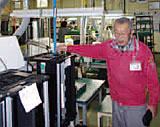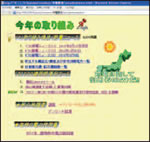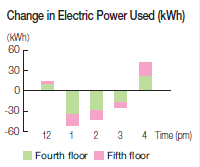Initiatives in FY 2012
Conserving Energy through “Visualization”
Results Monitoring in Real Time

As part of the rollout of energy use visualization systems in the azbil Group, Azbil Kimmon Wakayama Co., Ltd. began utilizing Azbil Corporation’s EneSCOPE™ energy management and analysis system and ENEOPT™pers, an energy control optimization package. Based on the information made available by these systems, the company planned and implemented numerous energy conservation measures in cooperation with Azbil’s engineers to achieve significant energy savings. The ability to check the effects of these measures in real time has been useful in validating them and making adjustments, and has enabled the company to conserve energy without adversely affecting the indoor work environment or the comfort of employees. Specific measures included the establishment of rules for the startup time of air conditioners during office hours and the revision of operating schedules for air conditioners in testing laboratories. Steady progress by implementing such measures resulted in a substantial reduction in the use of electric power and liquid petroleum gas, and an 18% reduction in CO2 emissions compared with fiscal year 2010. The company plans to further reduce CO2 emissions by adopting other new Azbil energy-saving solutions such as technologies for forecasting heat demand and optimizing cold and hot water temperatures.
Summer Electricity-Saving Initiatives
We evaluated and awarded special recognition to azbil Group sites not only for the results of their summer electricitysaving initiatives but also for the processes they used to implement those initiatives and achieve their targets.
Two of these sites in particular were recognized for excellence.
Production Site Initiatives

Underground water is used as cooling water in the reflow furnace
Located in Kita-Shinano in a region of lush greenery and abundant water, Azbil Taishin Co., Ltd. develops, designs, and manufactures electronic control systems, primarily for the azbil Group. The plentiful underground springs that bubble up from the premises have a stable temperature year-round, feeling cool in summer and warm in winter. Azbil Taishin takes advantage of this resource to save energy. For example, in 2012 it sprinkled the rooftops in summer, installed evaporative air coolers that use underground water instead of operating air conditioners, and used underground water to cool the high-temperature electric furnace (reflow furnace) that melts solder. The company also took various steps to reduce its power consumption during peak demand hours, including shutting down nitrogen generation equipment and switching over to liquefied nitrogen, dissipating heat from the reflow furnace and solder tanks, and installing reflective sheets on windows to filter out sunlight.
These initiatives were effective, as the company achieved a 20% reduction in electricity use during peak demand hours and a 22% reduction in overall electricity use in summer 2012 compared with the same period in 2010.
Sales Office Initiatives
While implementing power-saving measures in common areas and controlling power demand, FTC has also operated a website since fiscal year 2011 where workers can express their satisfaction level and wishes concerning the indoor environment, allowing real-time reception of and response to opinions. Responding to feedback, to improve building user satisfaction FTC in summer 2012 allowed small desktop items such as USB-powered fans and desk lights, installed insulated curtains, and modified the precooling of the building. The insulated curtains were hung on westfacing windows from the third floor to the top floor of the seven-story building and were effective in shielding offices from the heat of the afternoon sun. The entire building was precooled before the start of working hours in order to shift electricity use out of the peak demand period, and the majority of employees said that the cooler environment was more comfortable.
Initiatives to Balance the Conservation of Electricity with Workplace Productivity
Measures designed to save electricity at the Fujisawa Technology Center (FTC) in Kanagawa Prefecture, one of the azbil Group’s key facilities, aim to strike a balance with the need to maintain workplace productivity.
Monitoring and Responding to Building User Satisfaction Level

Sharing information on an electricity conservation website for building users
While implementing power-saving measures in common areas and controlling power demand, FTC has also operated a website since fiscal year 2011 where workers can express their satisfaction level and wishes concerning the indoor environment, allowing real-time reception of and response to opinions. Responding to feedback, to improve building user satisfaction FTC in summer 2012 allowed small desktop items such as USB-powered fans and desk lights, installed insulated curtains, and modified the precooling of the building. The insulated curtains were hung on westfacing windows from the third floor to the top floor of the seven-story building and were effective in shielding offices from the heat of the afternoon sun. The entire building was precooled before the start of working hours in order to shift electricity use out of the peak demand period, and the majority of employees said that the cooler environment was more comfortable. However, 30% said they felt cold or became cold after a while. Accordingly, the precooling settings were modified in the summer of 2012 to improve the indoor environment and achieve a more balanced shift to off-peak hours.
Experimental Automated Demand Response

Energy savings from implementing automated demand response (1–4 pm)
In conjunction with the Central Research Institute of Electric Power Industry, automated demand response* was implemented on a trial basis on certain floors of buildings where a building energy management system (BEMS) was in use and where energy visualization had made sufficient progress. Currently, practical energysaving technologies are being developed that include features to maintain the workplace productivity of occupants, with a view toward the widespread use of such technologies in office buildings in the future.
* Demand response is a mechanism by which enduse customers adjust their demand for electricity in response to electric power supply-and-demand conditions, such as shortages or surpluses. Amid nationwide power shortages since the March 2011 earthquake and tsunami, demand response has received attention as a way of curbing electricity use during peak hours.
- Overall of Environmental Initiatives
- Contributing to the environment through our core businesses
- Reducing the environmental impact of our own business activities
